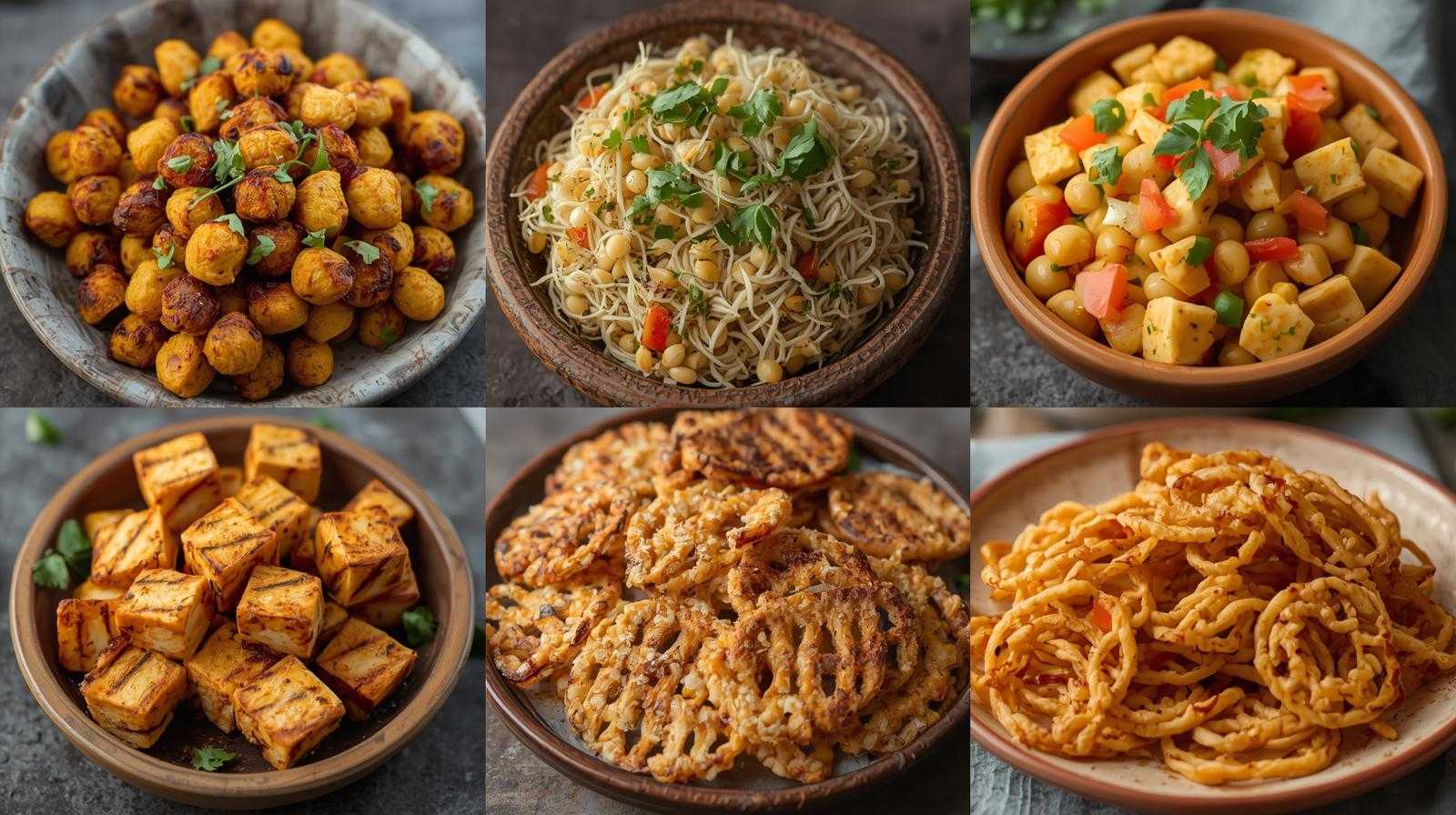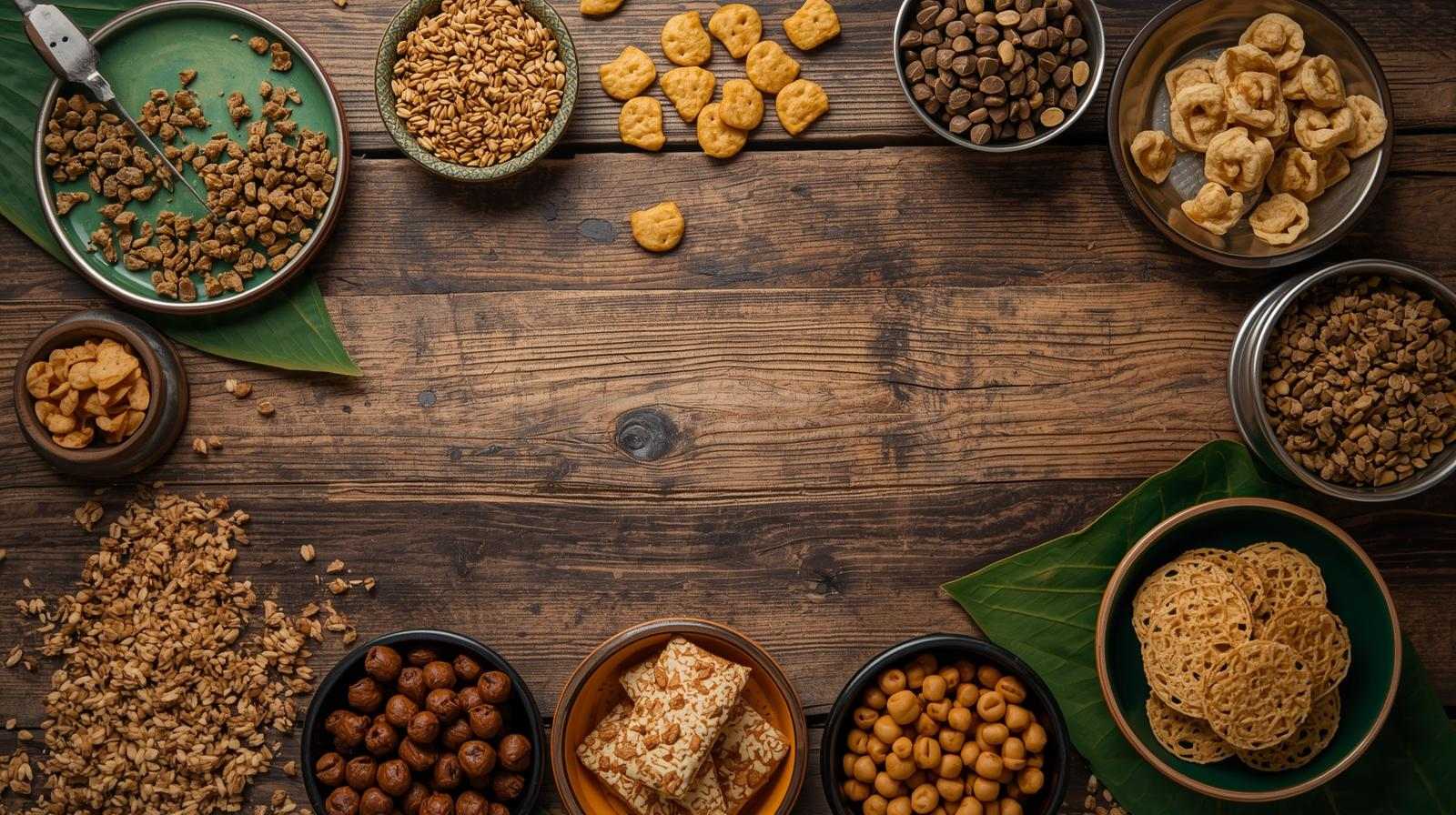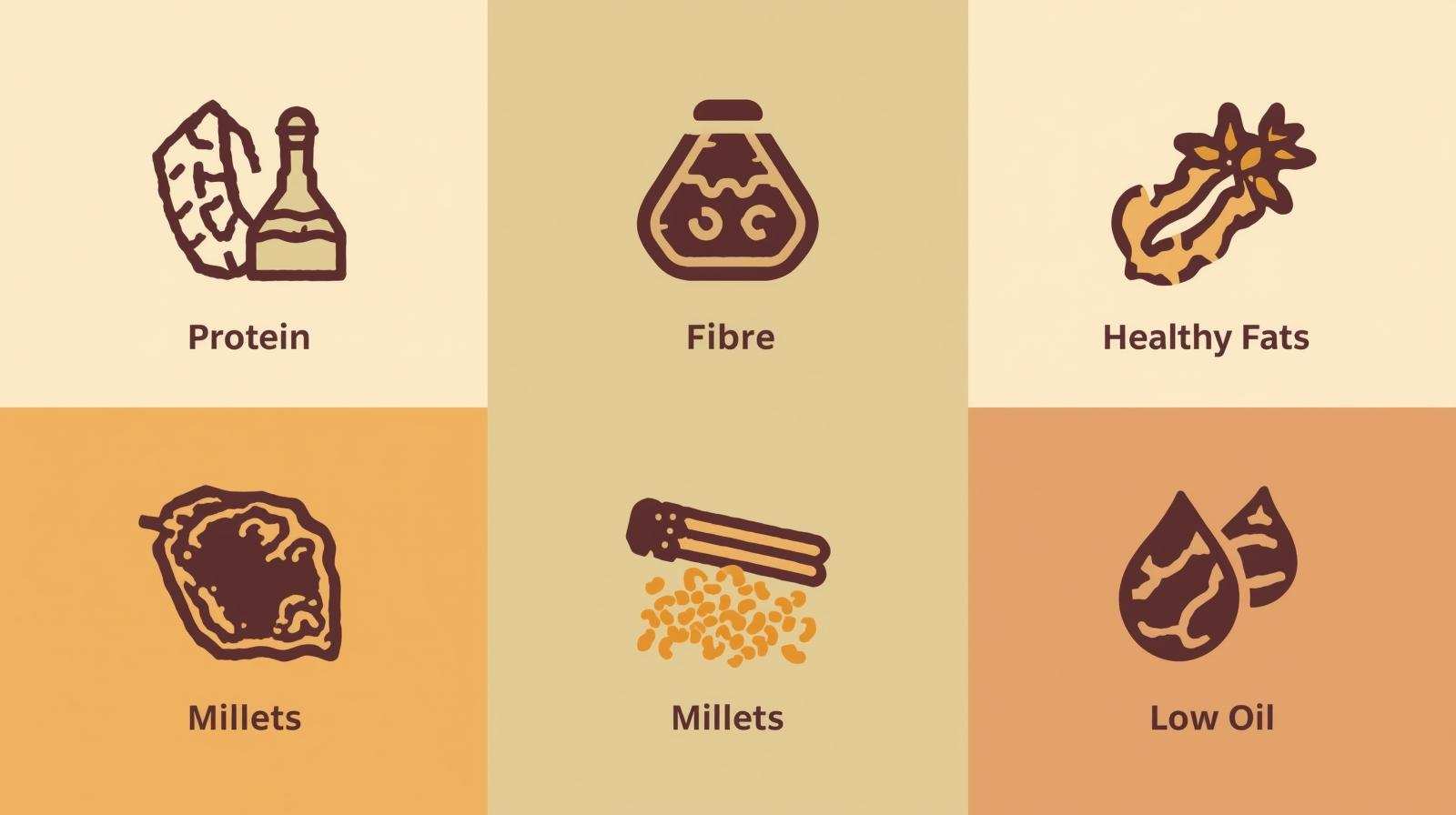Reinventing the Crunch: India’s Heritage Foods in a Modern Fitness Era

Introductory
Have you ever paused mid-snack and thought: “What connects my grandmother’s savoury, crunchy namkeen with the protein bites I munch after a workout?” It’s a question that spans centuries of Indian culinary tradition and today’s fitness-food movement.
In this article, we explore heritage food, fitness foods, and crunchy delights — and more importantly, how they converge in modern India.
1. What we mean by Heritage Food
In India, “heritage food” refers to recipes, ingredients, and methods passed down generations — often region-specific, rooted in local culture and climate. For instance:

-
Consider the snack Murukku: a spiral, crunchy treat from South India made of rice flour and urad dal flour. Wikipedia+1
-
Or the equally familiar Chakli (also known as chakri) from Maharashtra, made from rice, gram, and black-gram flours. Wikipedia
-
These foods are not merely snacks — they embody regional flavours, communal occasions (festivals, tea-time), and generations of craftsmanship.
Why does heritage food matter now? Because as we attempt to stay fit in modern India, the question arises: can these old recipes still serve our nutritional needs? Or do we need to reinvent them? That brings us to our next section.
2. The Rise of Fitness Foods in India
Over the last decade, our country has seen a surge in health-and-fitness awareness. With gym culture growing, nutrition being discussed on social media, a shift in snack preferences is underway.

Key insights:
-
A recent article lists “healthy desi snacks … perfect for weight loss”, recommending items like roasted foxtail (makhana), millet khakhra and sprouted moong chaat. The Times of India+1
-
Another review highlights that snacks rich in protein and fibre help satiety and better health outcomes. PFNDAI
In short: Fitness foods in India are no longer imported shakes and bars alone — they are home-grown, legume-, millet- or seed-based snacks designed to meet modern lifestyle needs.
3. Understanding Crunchy Delights
Crunchiness is a major reason we reach for a snack. There’s something satisfying about that texture. Yet from a nutrition standpoint, crunchy doesn’t always mean healthy.
Some thoughts:
-
Traditional crunchy snacks (like sev, fried namkeen) are deep-fried and high in oil/fat. For example, Sev is made from chickpea flour and fried. Wikipedia
-
On the flip side, healthy crunchy alternatives are emerging: roasted pulses, makhana (fox nuts), millet crackers, etc. These offer better nutrient profiles (higher fibre, less oil) while preserving the desirable crunch. The Economic Times
-
The challenge is to retain that crunch and make it compatible with fitness goals — reduced saturated fat, good fats instead, adequate protein/fibre.
4. Where Heritage Food Meets Fitness Foods via Crunchy Delights
This is the intersection we’re aiming to explore: how old-world snacks can be adapted (or are already adapted) to modern fitness-oriented eating.

4.1 Adapting heritage snacks
-
Replace part of the flour (maida/refined) in traditional snacks with millet (ragi, jowar) or pulses.
-
Opt for baking or air-frying vs deep-frying while retaining shape, crunch, and tradition.
-
Add seeds/nuts for extra protein and good fats to the snack mix.
4.2 Examples from the Indian context
-
A khakhra made of bajra/jowar (millets) rather than just wheat — crunchy, heritage in texture, fitness-worthy in nutritional profile. The Times of India
-
Roasted makhana (fox nuts) dressed with mild spices — crunchy, low in fat, historically Indian, now emphasised in fitness behaviour. The Economic Times
4.3 Benefits of this convergence
-
Familiarity + nostalgia: People are more likely to adopt and enjoy snacks that feel culturally familiar.
-
Better nutrient profile: Heritage sensibilities + modern nutrition = snacks that satisfy texture and taste and support health goals.
-
Sustainable culture: Promoting local grains, pulses, and heritage ingredients aligns with both health and food-culture continuity.
5. Nutritional Framework: What to look for
For snack foods (especially crunchy ones) in a fitness-oriented Indian context, here are key parameters we recommend:

-
Protein: To support muscle maintenance, satiety. (E.g., sprouted moong, paneer cubes) The Times of India
-
Whole grains/millets / pulses: For slow-digesting carbs, fibre. Fit & Flex
-
Healthy fats: Seeds, nuts, minimal saturated oil.
-
Low/controlled oil & frying: Deep-fried = higher fat; roasted/fewer fried surfaces = better.
-
Crunch texture without empty calories: Must deliver crunchy delight and good nutrition.
-
Cultural acceptability: Ingredients familiar to the Indian palate & cooking style.
6. Challenges in the Indian Snack Landscape
While the convergence is promising, there are roadblocks we observe:
-
True nutrition vs perception: Some snacks marketed as “healthy crunchy” may still have high-calorie or low-nutrient profiles. For example, even low-oil roasted makhana can add up in calories if portions are uncontrolled. The Times of India
-
Cost and accessibility: Millets, pulses, and speciality roasting processes may cost more or be less available in small towns.
-
Taste & texture compromise: Heritage snacks are loved for taste & crunch; altering them to be healthier sometimes adversely affects the sensory experience unless done well.
-
Education & consumer behaviour: Many consumers still default to conventional crunchy namkeen without awareness of healthier alternatives.
-
Scaling manufacturing with integrity: Ensuring that large-scale snack manufacturers maintain low oil, minimal preservatives, and good nutritional standards.
7. Practical Snack Ideas for Indian Homes
Here are some snack ideas where we combine heritage, fitness orientation, and crunch:

-
Roasted makhana tossed with light ghee (or oil), turmeric, mild chilli, and a sprinkle of sesame seeds.
-
Millet khakhra (jowar/bajra) with light sesame oil & cumin — crunchy tea-time snack.
-
Sprouted moong chaat: lightly roasted sprouted moong, chopped onions/tomatoes, lemon, coriander — crunchy, protein-rich.
-
Paneer cubes marinated in light spice, grilled/air-fried; serve as crunchy cubes.
-
Homemade baked “chakli” version: using partly millets & pulses, baked instead of deep-fried, retaining spiral crunchy form.
-
Exotic fusion: millet popcorn, seed-crusted roasted chickpeas.
8. How We Recommend Incorporating Them into Your Routine
As a collective (“we, us, our”), following a routine helps:
-
Plan: At the start of the week, select 2-3 “snack times” and pick the healthier crunchy snack rather than defaulting to heavy fried.
-
Portion control: Crunchy snacks tempt overeating. Pre-portion, e.g., small bowl rather than eating from a large container.
-
Balance with other meals: If the snack is crunchy and rich, keep the next meal lighter & focus on veggies/salads.
-
Combine with activity: After a fitness session, choose a crunchy snack high in protein/fibre rather than sugar-rich.
-
Enjoy mindfully: Part of the appeal is heritage, texture, taste. Let the crunch satisfy without guilt.
-
Rotate flavours: To avoid monotony and over-consumption, mix up snack types – pulses one day, millet another, seeds the next.
9. The Future: Trends we see
-
Demand for healthier, crunchy & heritage-rooted snacks in India is rising. For example, over 55 % of Indian consumers now prefer preservative-free snacks. The Economic Times
-
More brands will combine heritage ingredients (millets, pulses, seeds) + crunchy formats + fitness claims.
-
Smaller kitchens and home-entrepreneurs will also create niche snacks: millet puffs, seed-crackers, etc.
-
Nutrition tech/AI may help better snack design and food composition analysis in the Indian context. arXiv
Conclusion
When we step back, the journey of snack food in India reflects a beautiful circle: from heritage recipes crafted by generations, to modern fitness-focused snacks seeking nutrition, and the thread that ties them both is the crunch. A satisfying texture, a familiar flavour, and a modern nutrient profile: that’s the sweet spot.
For us, embracing heritage food doesn’t mean ignoring our fitness goals — rather, re-imagining those heritage snacks in light of modern nutritional needs. When we do that, crunchy delights become not just indulgence, but an integral part of a balanced, Indian-rooted, fitness-aware lifestyle.
Key Takeaways
-
Heritage foods in India carry taste, culture, texture — and offer a rich foundation for modern snack innovation.
-
Fitness-oriented snacks emphasise protein, fibre, whole grains, and better fats — increasingly important in India’s diet landscape.
-
Crunchy texture remains important: the goal is to retain it and improve nutritional quality (less oil, better ingredients).
-
Combining heritage + fitness + crunch yields snacks that satisfy on taste, culture and health fronts.
-
Practical snack ideas and routine planning help make this convergence real in our daily lives.
-
Trends point towards more preservative-free, heritage-inspired, nutrition-forward crunchy snacks in the Indian market.
FAQ
Q: Are all crispy/ crunchy Indian snacks unhealthy by default?
A: Not necessarily. Many traditional crunchy snacks (e.g., murukku, chakli) are deep-fried and high in oil/fat, which can raise calorie load. Wikipedia+1 But when prepared thoughtfully (less oil, good ingredients), crunchy snacks can fit into a healthy routine.
Q: Can heritage snacks be adapted for fitness diets?
A: Yes — by substituting refined flours with millets/pulses, using roasting/air-frying instead of deep-frying, adding seeds/nuts for protein, and controlling portion size.
Q: What makes a crunchy snack “fitness-friendly” in the Indian context?
A: Key attributes: high in protein and/or fibre, made from whole grains/millets/pulses, minimal unhealthy fats, retains crunch, culturally acceptable. For example, roasted makhana (fox nuts) is cited as a crunchy snack that supports weight loss. The Economic Times
Q: How do we manage portion control when the snack is delicious and crunchy?
A: Some strategies: pre-serve small portions in a bowl; avoid eating straight from a large packet; alternate snacks with water/tea to reduce mindless munching; mix snacks with something else (e.g., roasted chickpeas + veggies) to dilute calorie density.
Q: Are there any pitfalls or hidden issues with “healthy crunchy” snacks?
A: Yes — even snacks marketed as healthy can add up in calories if portion uncontrolled. Also, some ingredients (even millets/roasted nuts) can have potassium, fats, or oils that may not suit certain health conditions. For example, a note about makhana: despite being healthy-labelled, it may be low in fibre and can cause issues if over-consumed.



